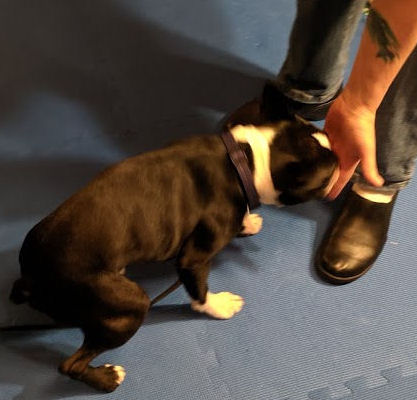Is your dog a habitual “one and done” kind of guy? As soon as they get a reward, are they gone, looking for something else to do? The bad news is – it’s your fault. The good news is, it’s pretty easy to fix.
How it happened
If your dog is saying “bye!” after a single reward, they’re reflecting what they’ve learned from you. They don’t expect any more, so there’s no reason to stick around. Give them a reason to stay and they will.
Fix it

The “Touch!” game is a good one to use for demonstration. As a refresher, you hold the palm of your hand in front of your dog and say “Touch!” When your dog touches your palm with his/her nose, with your other hand, you bring a treat to the open palm and deliver it into your dog’s mouth. It’s a simple game. And incredibly useful to get your dog’s focus and attention back to you when they spot that enticing squirrel on a walk, cat at the vet’s office, or bicyclist about to pass on your walk.
The key to the game is leaving your open palm in place in front of your dog. It doesn’t move for the duration of the game. If you’ve been in the habit of using that hand to reward your dog, or moving it away after the “Touch,” you’ve created the “one and done.” Just leave it there. And every time your dog bops his/her nose in your palm, they get another treat. Every single time.
Promises kept
When can you randomize or lessen the number of treats? You can space out the treats when your dog knows the game thoroughly and loves playing it for its own sake. When the value of the treat has transferred to loving smashing his/her face into your palm. And even then, when it’s your dog’s favorite game and they’ll run through proverbial fire to play, you still hand over the reward the majority of the time.
Same thing with every single behavior that requires duration. If your dog is disengaging after a single reward, it’s because they don’t expect more. Surprise them! If you’re working on a down, give three treats in rapid succession, delivered between your dog’s front paws. Then give a release or “That’s all!” cue to let your dog know the game’s over.
It works for games that require motion, too. If you’re working on loose-leash walking, give a reward every single time your dog looks up at you from the correct position at your side.
Your dog knows if you’re being stingy
Dogs aren’t stupid. If you’re stingy, your dog knows it. They have no reason to keep doing whatever it was that got them one treat after they get it.
If, on the other hand, the dog has no idea when the next cookie will be coming his way, he’ll stick around and keep doing the “good” stuff in hopes of being rewarded. Don’t disappoint them!
Dogs are eternal optimists
It’s true. Dogs are always ready to believe that you’ll deliver delightful things. If you give them a reason to keep doing what they’re doing, they’ll keep doing it. What gets rewarded, gets repeated. Give your dog a reason to keep going.






